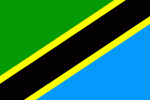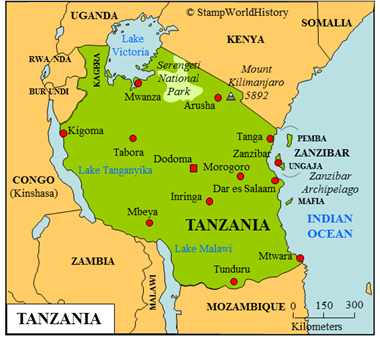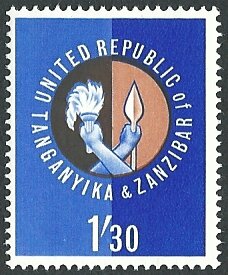
Tanzania
Quick reference
General issues: United republic of Tanganyika & Zanzibar 1964, Tanzania 1965-Present
Country name on general issues: United republic of Tanganyika & Zanzibar, Tanzania
Related issues: East African Community and predecessors 1964-1977
Currency: 1 (Tanzania) Shilling = 100 Cent 1964-Present
Population: 11 390 000 in 1964, 49 250 000 in 2013
Political history Tanzania
Tanzania is located in eastern Africa. Tanzania came into existence as a union of Tanganyika and Zanzibar.
Tanganyika
Tanganyika is the part of Tanzania on the African mainland. Until WWI, Tanganyika is the larger part of German East Africa. German East Africa is, during WWI, occupied by the Allies, and at the 1919 treaty of Versailles, divided into the Belgian mandated territory of Ruanda-Urundi and the British mandated territory of Tanganyika. The British mandate for Tanganyika will – like the Belgian mandate for Ruanda-Urundi – be renewed by the United Nations in 1946 when Tanganyika becomes a United Nations trust territory.
Tanganyika engages in several forms of cooperation with the other British possessions in eastern Africa – Kenya and Uganda. In 1930, Tanganyika joins the East African Posts and Telecommunications Union with Kenya and Uganda. The cooperation between the three countries, in subsequent years, will go by different names: from 1948, the East African High Commission, from 1961, the East African Common Services Organization and from 1967, the East African Community. The East African Community is dissolved in 1977.
Tanganyika will gain independence within the British Commonwealth in 1961 and becomes a republic in 1962.
Zanzibar

Wildebeest in the Serengeti National Park. The migration of the wildebeest is the largest mammal migration on earth. And not without danger….
In the 19th century, Zanzibar is a sultanate consisting of the Zanzibar Archipelago, the coastal region of the east African mainland from Mozambique in the south to Somalia in the north and territories along the caravan routes from the coast to Lake Tanganyika and Congo. In the second part of the 19th century, more and more of these territories are ceded mainly to British East Africa and German East Africa. In 1890, Zanzibar becomes a British protectorate.
Zanzibar will gain independence as the sultanate of Zanzibar in 1963 and becomes the republic of Zanzibar in 1964.
Tanzania
The republics of Tanganyika and Zanzibar will, in 1964, join to form the United Republic of Tanganyika & Zanzibar that later will change its name to Tanzania. Tanzania, from its foundation in 1964, is governed from a one party political system – the first multi party elections are held in 1995. Zanzibar, within the federation, has a form of self government for which it has its own parliament. Tanzania is a member of the East African Community until the East African Union is dissolved in 1977. In 1973, the capital was moved from Dar es Salaam to Dodoma. Dar es Salaam remains the commercial center of the country.
In its foreign policy, Tanzania is, in 1978, confronted with an invasion from Uganda – Uganda aiming to annex the Kagera province. Tanzania gains the upper hand, forces Uganda to withdraw and, in its turn, invades Uganda. The war ends in 1979 in the status quo ante bellum – albeit that the Tanzania invasion leads to the fall of the Idi Amin dictatorial regime in Uganda.
Economically, Tanzania long will be a socialist style, government controlled economy. From the 1980’s, Tanzania is gradually transformed into a free trade economy. The most important sector in the economy is agriculture. The majority of the population consists of Swahili speaking Bantu peoples – Zanzibar having a substantial Arab minority. Tanzania is known for its nature reserves, such as the Serengeti National Park. Within its borders, Tanzania has Mount Kilimanjaro, the tallest mountain on the African continent.
Postal history Tanzania
The first post offices to be opened in the future Tanzania are the offices abroad of British India, Germany and France on Zanzibar. On the African mainland, the first post offices are opened by the Germans from 1890.
On the mainland, stamps will be used as follows:
- stamps of Germany from 1890 to 1893 and of German East Africa from 1893 until 1917,
- stamps issued by the occupying Allied forces from 1915 until 1922 – please refer to the profile of German East Africa for a detailed description,
- stamps issued by the mandated territory of Tanganyika from 1922 until 1935,
- stamps issued by the East African Community and its predecessors from 1935.
In Zanzibar, stamps issued by the protectorate of Zanzibar will be used from 1895 – these to be superseded by the issues of the sultanate of Zanzibar in 1963 and the republic of Zanzibar in 1964.
The United Republic of Tanganyika & Zanzibar will issue one set of stamps in 1964 – commemorating the founding of the United Republic. Tanzania will issue stamps from 1965. The stamps of the United Republic and of Tanzania will, until 1977, be used concurrently with the issues of the East African Community. Initially, these issues are valid only on the mainland in the former Tanganyika. Zanzibar will continue to issue stamps until 1967, that are, in 1968, superseded by the issues of Tanzania and the joint issues of the East African Community.
Album pages
← Previous page: TanganyikaNext page: Tete →






On the map of Tanzania I would indicate the political capital (red square) as Dodoma and change the current red square used for Dar es Salaam to a circle, as Dar es Salaam is considered the major commercial city.
William
William
Thanks. I updated the map and added some text to reflect the current situation.